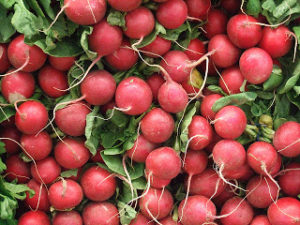Radishes are the edible root of a rapidly germinating plant of the Brassicaceae family. In fact, the word radish derives from the Greek word Raphanus, which literally means to “appear quickly”. Most radish varieties take 25-30 days to mature from seed to full-sized root. Like many edibles in the Brassicaceae family, they also thrive in cooler temperatures, making them the perfect seed to use in a winter experiment.

Photo of radishes courtesy of Allison P. (Worldharmony).
CONCEPTS:
This experiment should help students understand the ideal population densities for radish crops and prompt them to hypothesize how nutrient uptake and availability is impacted by population density.
–Population density (plants): Can be defined as the amount of plants contained within a spatial parameter (e.g. the number of radish plants in one square foot). Population density studies are often referred to as “crowding” studies. In this case we are examining plants, but population density is a ubiquitous topic in biology and can refer to any organism, even humans.
–Nutrient uptake and availability: Refers to the amount of critical elements, such as carbon, nitrogen, phosphorous and potassium, as well as water and sunlight, that are readily available to the plant and the ability of the plant to procure those elements from the environment. Uptake and availability can be severely impacted by plant density as competition between plants increases with higher densities.
PROCEDURE:
To do the experiment you will need radish seeds, a planting area with at least 24 square feet (this can be noncontiguous-raised beds or pots are fine), a ruler, and a scale.
-Section off six 2 ft. x 2 ft. areas, for a total of six 4 sq. ft. sections.
-Two of the 4 sq. ft. sections will be used for 1-inch planting densities, two sections will be used for 2-inch planting densities, and the remaining two sections will be used for 4-inch planting densities.
-Use the ruler to help you plant seeds and space them according to the image below. If you are planting the 4-inch density section, make sure each seed is equidistant from the other seeds. Use the image below as a guide:
-Once the seeds are planted, be sure to water each section at the same time and with the same amount of water. You can also use the planting guide on the back of the seed packet to identify ideal watering and planting conditions.
-Take notes on how the plants grow at one week intervals and use these observations to hypothesize which planting density is best for radishes.
-After thirty days, make your final observations about the growth of the plant and pull the radishes, but be careful to keep each section separate.
-Next, weigh each section individually using a scale and record your values.
QUESTIONS:
Based on your findings, can you determine which density was ideal for radishes? How did your hypothesis based on your observations differ from your final results? Did the density of the radishes appear to have any effect on the weight or total amount of radishes in each section? Were the findings between similar sections identical or did they vary?


